

Neuroscience, psychology and education: Emerging links. Keep them guessing, keep them gaming: Uncertain rewards motivate consumers to make repeat purchases. Marketers everywhere are looking for what will entice consumers to make a purchase -- not just once but repeatedly -- and new research points to a rather surprising result.
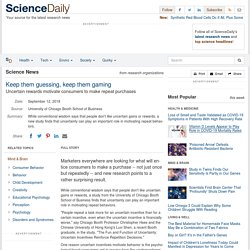
Neuromyths: The 10 Top Misconceptions about your Brain. Some of us are ‘left-brained’ and some are ‘right-brained,’ and this helps explain differences in how we learn.

FALSE. The left and right hemispheres of the brain work together. There is no evidence that people’s learning differs in important ways based on one hemisphere being more dominant than the other. Cbe. Brainworldmagazine. The Untold Story of Neuroscience’s Most Famous Brain. List of Famous Neuroscientists - Biographies, Timelines, Trivia & Life History. Neuroscience of Learning and Development1. Educational neuroscience. The potential of educational neuroscience has received varying degrees of support from both cognitive neuroscientists and educators.
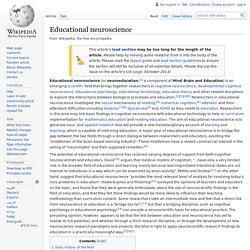
Davis[10] argues that medical models of cognition, "...have only a very limited role in the broader field of education and learning mainly because learning-related intentional states are not internal to individuals in a way which can be examined by brain activity". Pettito and Dunbar[11] on the other hand, suggest that educational neuroscience "provides the most relevant level of analysis for resolving today’s core problems in education". 30 Most Influential Neuroscientists Alive Today - Online Psychology Degree Guide. Image Source By Kelsey Fox From detailed brain mapping to groundbreaking technology for quadriplegics, some exciting innovation is occurring in the field of neuroscience today.
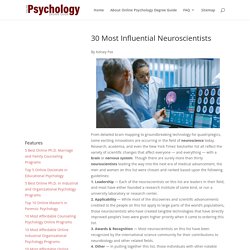
Research, academia, and even the New York Times’ bestseller list all reflect the variety of scientific changes that affect everyone — and everything — with a brain or nervous system. Though there are surely more than thirty neuroscientists leading the way into the next era of medical advancement, the men and women on this list were chosen and ranked based upon the following guidelines:1. Leadership — Each of the neuroscientists on this list are leaders in their field, and most have either founded a research institute of some kind, or run a university laboratory or research center.2. 30. Leah Krubitzer is a neuroscientist and professor at University of California at Davis, where she also heads up the Laboratory of Evolutionary Neurobiology. 29.
Image Source 28. Image Source 27. Image Source 26. Image Source 25. 24. 9. How to Plan Instruction Using the Video Game Model. Achievable Challenge Requires Individualization As I wrote in my previous blog, A Neurologist Makes the Case for the Video Game Model as a Learning Tool blog and the accompanying video, the most popular computer games take players through increasingly challenging levels as they became more and more skillful.

As skill improves, the next challenge stimulates new mastery to just the right extent that the player could reach with practice and persistence. Students need challenge suited to their background knowledge and abilities if they are to remain motivated to persevere and build mastery of foundational knowledge. The video game model is ideal for kids lacking in foundational knowledge, but it is not necessary for all kids at all times.
Games are intrisincally motiating by design; the teacher doesn't need to design this. A Neurologist Makes the Case for Teaching Teachers About the Brain. Even though I was a physician with a strong science background, when I decided to become a classroom teacher (and thought I'd teach science), I did not want to make that career change without the benefit of instruction and guided student teaching.
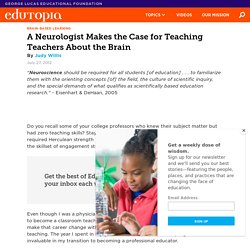
The year I spent in my graduate school of education program was invaluable in my transition to becoming a professional educator. Curriculum in schools of education has changed in response to changes in society, pedagogy and technology. As computer technology became an asset in classrooms, schools of education appropriately included that instruction in the curriculum. Many states made similar education program curriculum adaptations in response to multiculturism, increases in English language learners, and the use of the concrete-connect-abstract progression in math instruction.
Neuroscience Knowledge Strengthens the Lifeline What Triggers Student Behavior Bringing Neuroscience into Education Frontloading is More Critical Than Ever. Cognitive Research: Principles and Implications. While tests are most often used in educational settings for assessment, a lesser-known benefit of tests is that they actually improve memory of the tested information.
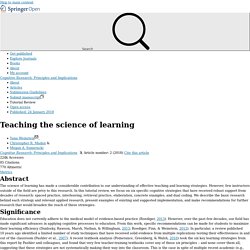
If we think of our memories as libraries of information, then it may seem surprising that retrieval (which happens when we take a test) improves memory; however, we know from a century of research that retrieving knowledge actually strengthens it (see Karpicke, Lehman, & Aue, 2014). Testing was shown to strengthen memory as early as 100 years ago (Gates, 1917), and there has been a surge of research in the last decade on the mnemonic benefits of testing, or retrieval practice. A debate is currently ongoing as to the effectiveness of retrieval practice for more complex materials (Karpicke & Aue, 2015; Roelle & Berthold, 2017; Van Gog & Sweller, 2015).
Trainingjournal. Why Learning Neuroscience Matters. The only way businesses can maintain their competitive advantage in this rapidly changing, information soaked world is to out-think, out-learn, and out-create the competition.
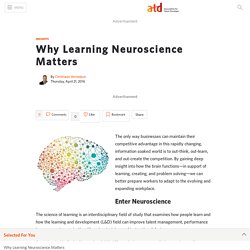
By gaining deep insight into how the brain functions—in support of learning, creating, and problem solving—we can better prepare workers to adapt to the evolving and expanding workplace. Enter Neuroscience The science of learning is an interdisciplinary field of study that examines how people learn and how the learning and development (L&D) field can improve talent management, performance improvement, organizational learning, training, and instructional design. According to Dr. The Neuroscience of Learning, Memory, and Emotions. In the 1950s, a young man with permanent amnesia changed what we know about learning and memory.
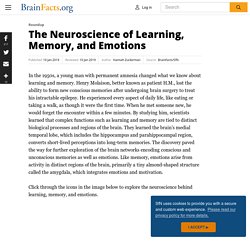
Henry Molaison, better known as patient H.M., lost the ability to form new conscious memories after undergoing brain surgery to treat his intractable epilepsy. He experienced every aspect of daily life, like eating or taking a walk, as though it were the first time. When he met someone new, he would forget the encounter within a few minutes. Neuroscience and How Students Learn. This article is based on a talk by Daniela Kaufer, associate professor in the Integrative Biology department, for the GSI Center’s How Students Learn series in Spring 2011.
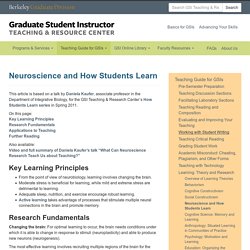
On this page:Key Learning PrinciplesNeuroscience FundamentalsApplications to TeachingFurther Reading Also available:Video and full summary of the talk “What can Neuroscience Research Teach Us about Teaching?” The Neuroscience Of Learning: 41 Terms Every Teacher Should Know. The Neuroscience Of Learning: 41 Terms Every Teacher Should Know by Judy Willis M.D., M.Ed., radteach.com As education continues to evolve, adding in new trends, technologies, standards, and 21st century thinking habits, there is one constant that doesn’t change.